#153 Design
Photo

#green#peach#gif#art#digital art#color#colors#colorful#artists on tumblr#creative coding#visuals#satisfying#abstract#visual stim#design#soothing#gifs#loop#arte#beautiful#YIQ#*d44#*h 153#*ky1#*pfn e0 sp0 r122#*c63.237.50.179.147.181#*mp0779.0000.0009#*tp0547.0000.0006
39 notes
·
View notes
Text
LLOYD FRONTERA, OUR YOUNG MASTER WHO WAS FORMERLY KIM SUHO, IS BACK IN KOREA AND HE'S THIS CLOSE TO HAVING A PANIC ATTACK *SOBS*
#tged#the greatest estate developer#the greatest estate designer#tged spoilers#spoilers#manhwa chapter 153
23 notes
·
View notes
Photo

Yenilenmenin tam zamanı... Doğal mavi akik taşının hint boncuğu birleşimi otantik tasarım bileklikler ile şıklığını tamamla farkını hissettir... Sipariş için lütfen DM... * Ürünlerimiz butik çalışması olduğundan her ürünün devamı bulunmamaktadır. #153 #design #ssdesign #serapsaritasdesign #celebrate #fashion #style #jewelry #küpe #kolye #necklace #hediye #gift #purse #glam #love #cute #selfie #tiktok #keşfet #model #shopsmall #beauty #luxury #followforfollow #keşfetteyiz #Bracelet https://www.instagram.com/p/CkgDyyaq173/?igshid=NGJjMDIxMWI=
#153#design#ssdesign#serapsaritasdesign#celebrate#fashion#style#jewelry#küpe#kolye#necklace#hediye#gift#purse#glam#love#cute#selfie#tiktok#keşfet#model#shopsmall#beauty#luxury#followforfollow#keşfetteyiz#bracelet
1 note
·
View note
Text

[Day 153] i cannot figure out this design FOR THE LIFE OF MEE!! so i officially give up. heres my take on s10 ren as a starwars-y scavanger and stuff ^_^
#its very messy i know.... you dont want to know how many times i redrew this design over and over again... its been a struggle#dailyrd#rendog#rendog fanart#hermitcraft fanart#hermitcraft#mod woop
367 notes
·
View notes
Text
Klingons & Racialisation - the Long Post
This post is an overview of the racial coding of the Klingons from their first appearance to the present day, illustrated by quotes from Trek writers, actors and crew members taken from the Memory Alpha article Depicting Klingons, with my own interjected summaries and explanations. It is by no means comprehensive (I likely missed some stuff), and does not offer critical analysis of the quotes provided, but nonetheless is intended to demonstrate irreproachably the open fact that Klingons have always been intentionally written and designed as non-white -- something that fandom consistently fails to take into account when perpetuating racist stereotypes and reiterating racist canon content. I recommend reading the whole article for a more in-depth understanding of the subject, as well as seeking out the existing writing of fans of colour. This post is primarily for reference purposes so I've tried to limit my own analysis and opinions, but I do post those in my Klingon tag as well as more general headcanons and worldbuilding and I'm happy to answer any (good faith) questions this post may raise.
As always, if I have overstepped in any way as a white fan in making this post, I am grateful to be informed and will make any required changes.
Content warning for outdated and offensive language under the cut.
The Original Series
"There is some suggestion that the Klingons represent a Cold Warrior's view of China in the 1960s – swarthy, brutally repressive." (Star Trek Magazine issue 153, p. 66)
"And I think he was basing a lot of it on the kind of attitude of the Japanese in World War II...." ("Errand of Mercy" Starfleet Access, TOS Season 1 Blu-ray)
The script of "Errand of Mercy" introduces the Klingon look by saying, "We see the Klingons are Orientals,"
"Spray my hair black, give me a kind of swamp creature green olivey mud reptilian make-up, and we'll borrow some stuff from Fu Manchu, and put a long moustache and eyebrows on me." ("The Sword of Colicos", Star Trek: Deep Space Nine - The Official Poster Magazine, No. 8)
"I think the makeup was called 'Mexican #1 or #2.' That was the name of the original makeup foundation – they actually had kind of racist names at the time, like 'Negro #1' and 'Mexican #2' – which was the basis for the original Star Trek makeups." (Star Trek Magazine issue 172, p. 59)
"In the original series, all they wore was a dark face and their black hair," Michael Westmore observed. ("Michael Westmore's Aliens: Season Two", DS9 Season 2 DVD special features)
The Klingons' appearance changed within the original Star Trek series; although dark makeup and heavy eyebrows were the norm, the Klingons of "The Trouble with Tribbles" were much lighter-skinned and more Human-like in appearance.... He noticed that they are not only less like Mongol warriors by having less of a swarthy appearance but also by being slightly not as fierce... ("The Trouble with Tribbles" Starfleet Access, TOS Season 2 Blu-ray)
"...they were meant to represent the Communist foes of the United States specifically during the Vietnam War, which was being controversially fought at that time. (Star Trek: The Original Series 365, p. 222)
"...let us never set up a situation whereby those adversaries of ours [Klingons] give any indication of ever being anything but highly aggressive and self-seeking opponents." (These Are the Voyages: TOS Season Three)
Here it is explicitly stated that the Klingons were based on various Asian cultures, with the USSR also being mentioned heavily in the article. This influence and the use of "yellowface" is covered more comprehensively in this youtube video Klingons & The History Of Racial Coding. However, the video has some notable gaps which I hope to cover in this post.
Post-TOS (movies)
The Star Trek III portrayal of Klingons took inspiration from Japanese history. "Harve [Bennett] had the notion that the Klingons were like Samurai warriors," explained linguist Marc Okrand. (Star Trek: Communicator issue 114, p. 27) Robert Fletcher agreed with Bennett, later saying of the Klingons, "I always liked to think of them as authoritarian, almost feudal, like Japan had been." (The Making of the Trek Films, UK 3rd ed., p. 52)
Regarding the make-up, Michael Westmore observed, "Until now, Klingons were brown. Some had a bony ridge running down the middle of their foreheads, long black wigs and facial hair." (Star Trek: The Next Generation Makeup FX Journal, p. 28)
"I thought it was an ideal way for us to have our closure too, because the Klingons for us have always been the Communist Block, the Evil Empire. It just made sense to do that story." (The Making of the Trek Films, UK 3rd ed., p. 100)
"Gene was really bothered by the Klingons in VI [....] [They] were, in his words, 'too civilized, too decent, too much of the good guys in the story.' [....] [The Klingon detente] was not the way Gene would have handled it. He would have reversed it, he would have had the Klingons being the ones who couldn't handle the peace, with the Federation saying, 'Come on, let's try and work this out.'" (Star Trek Movie Memories, hardback ed., p. 289)
"The story never explored the Klingon culture the way I'd hoped it would [....] I was hoping for greater insight into the Klingons." (I Am Spock) Nimoy hoped, in specific, that the movie would provide some important insight into why the Klingons had "always been so angry, such nasty, vicious murderers." Nimoy wanted the insightful knowledge to be an intellectually transformational force, changing the thinking of Kirk and the audience. (Star Trek Movie Memories, hardback ed., pp. 287-288)
In an interview in the DS9 Season 7 DVD, Robert O'Reilly observed that a long-running joke among actors who have played Klingons is that they do not want to appear in the Star Trek films as, he believes, the only purpose of a Klingon in one of the films was to be killed off.
Although these last three quotes may not seem relevant, I believe they highlight an important facet of the racialisation of the Klingons. It reads as though Gene Roddenberry was against depicting the Klingons in a more sympathetic light than the Federation, and considering that the Klingons are intended to be non-white, refusing to give depth or motive to their anger in favour of keeping them "nasty, vicious murderers" comes across as fairly racist, especially when these kind of reductive and harmful stereotypes could've been challenged as Nimoy suggests. The treatment of Klingons as disposable villains is also concerning in this context.
The Next Generation
African-American actors were often cast as Klingons in TNG and subsequent Star Trek productions. This practice wasn't racially motivated but was instead carried out because it lessened makeup time, as the performers already had a brown complexion without having to have their skin painted that color. (Stardate Revisited: The Origin of Star Trek: TNG, Part 2: Launch, TNG Season 1 Blu-ray)
Tony Todd, who portrayed the recurring Klingon character Kurn, stated, "I don't look at the Klingons necessarily as African-Americans, but it's about tapping into something–they're certainly an alienated people, so maybe that's why African-American actors can identify with those characters. But that doesn't mean it's exclusive to them." (Star Trek: Communicator issue 116, p. 54)
Michael Westmore actually changed the Klingon facial design in numerous ways, though. He stated, "I added a Shakespearean style of facial hair and a forehead bone structure based on dinosaur vertebrae and I was able to modify motion picture Klingons for television." (Star Trek: Aliens & Artifacts, p. 59)
In "A Matter Of Honor", the Klingons were intended to be used to shed some light on a common social problem prevalent at the time of the episode's making. This was, namely, what it was like to be the only person of either white or black skin coloration while surrounded by people of the other color. The Klingons were selected to illustrate this theme as a spin on the usual arrangement of a predominantly Human crew serving aboard the Enterprise-D alongside Worf. (Captains' Logs: The Unauthorized Complete Trek Voyages, p. 176)
Two historical societies, the Samurai and Vikings, served as other inspirations, Moore perceiving about Klingon culture, "There was the calm, elegant reserve associated with the Samurai but there was the 'party-down' like the Vikings." (Star Trek: Communicator issue 114, p. 58)
"I stopped thinking of the Klingons as the Cold War adversary," he explained. "I didn't think it fit [....] The place where the Russians were when I was doing the Klingon shows just wasn't as relevant any more." (Star Trek: The Magazine Volume 1, Issue 19, pp. 64-65)
"The Klingons are not evil, tyrannical pirates bent only on pillage and plunder. They have a strict, almost unyielding code of ethics and honor and take their responsibilities as rulers seriously." Following a description of the Klingon homeworld, the memo continued by saying, "Klingon society could most closely be compared to that of Sparta or feudal Japan." ("Sins of the Father" audio commentary, TNG Season 3 Blu-ray)
Having recently seen the film Malcolm X, he imagined the Klingons in the "Birthright" duology as metaphors for black people. (Captains' Logs: The Unauthorized Complete Trek Voyages, p. 274; Star Trek: Communicator issue 105, p. 16)
"There's a certain way you have to carry yourself. You have to really be able to project the violence and the anger [....] All you have to do is think of the Spartans. They say, 'They'd rather have you come home dead on your shield than come home a coward.' [18]
This is where I feel the video essay previously mentioned falls short -- in the next gen era, Klingons are now explicitly black-coded. While some Asian cultural influences are still cited, they learn more towards the historical and are intermixed with other historical European influences (Spartans, Vikings, Shakespeare) rather than being fueled by contemporary prejudices towards the political enemies of the US as they were in the TOS era.
Deep Space Nine
Fields also generally based the Klingon group on American Western prototypes from the film The Magnificent Seven or, to a lesser extent, Japanese prototypes from The Magnificent Seven's movie source material, Seven Samurai. (Star Trek: Deep Space Nine Companion (pp. 131-132))
"So, the hair [...] was permed. So, it had more of a curl instead of the straight type look, and by perming it, they were able to kind of give them larger, bigger hair, so it was more like a mane." ("Michael Westmore's Aliens: Season Two", DS9 Season 2 DVD special features)
"I don't know how you could equate Klingons with what's going on in the world today," he admitted. "I think the intention was to make them like samurai. That hairdo they gave them is very much a samurai hairdo. A lot of the fight sequences, the moves with the bat'telh, are very much taken out of the Asian martial arts [....] It's very romantic you know, these three old guys, the Klingon over-the-hill gang." (The Official Star Trek: Deep Space Nine Magazine issue 15, pp. 17-18)
"It was different for them to get into this makeup, because [...] [the makeup was more elaborate and] the beards were bigger, and they were greyer, and they had curls to them, and the moustaches, they had the Fu Manchu look to them. So, they weren't used to sitting that long to be a Klingon." ("Michael Westmore's Aliens: Season Two", DS9 Season 2 DVD special features)
For recreating some old-style Klingons in "Trials and Tribble-ations", the Klingon-playing actors had to be made up with the same swarthy, shiny brown makeup as used in the original series. (The Magic of Tribbles: The Making of Trials and Tribble-ations)
...he had them unite in song, thinking this was "just the kind of thing that Klingons do" because they are, in his opinion, similar to Vikings. (Star Trek: Deep Space Nine Companion (p. 449))
"I always saw the Klingons as a combination of Japanese Samurai who haven't had their morning coffee (or tea!) and African Zulu warriors." [25]
In DS9 the only inspirations cited seem to be historical, once again leaning towards feudal Japan and the Vikings. Interestingly although the Klingons here are predominantly dark-skinned, I don't think that J.G. Hertzler, who is white, had his skin significantly darkened to play Martok (at least, not compared to the obvious brown makeup worn by other white actors playing Klingons). Having a white actor play a Klingon without dark makeup could've set a precedent decreasing the use of such practices later on, but no one seems to have picked up on it.
Enterprise
The Klingons of ENT: "Sleeping Dogs" were based on the crew of the Russian submarine Kursk. "For me," said Dekker, "the point was to acknowledge the Klingons as 'people' – to find them in a clear position of distress [....] The idea to 'humanize' their plight was mine, and it wasn't anything I thought about as far as canon. It just seemed right." (Star Trek: The Official Starships Collection, issue 41, pp. 10-12)
In the final draft script of "Affliction", the altered Klingons were initially referred to as "fierce-looking aliens" and were further described thus; "The aliens have a swarthy complexion, and dark facial hair... they could easily be mistaken for Humans. We'll eventually learn these are Klinqons... but their cranial ridges have disappeared."
At this point in time it seems the Klingons had essentially done a 180 from one-dimensional villains to sympathetic fan favourites, while still retaining the skin-darkening aspect of their makeup and "barbaric" characterisation. Although this is not mentioned in the article's section on the Abrams films, the images provided do demonstrate a level of skin darkening for the Klingons' brief appearance in Into Darkness.
The final section of the article is incomplete, meaning I don't have a lot of information for Discovery's redesign of the Klingons. The sources I can find cite ancient civilisations such as the Byzantines as well as Islamic architecture as inspiration for the set design, with a baroque influence on the costumes. I have heard rumours that the crew of Discovery have cited North African cultures as their inspiration for the Klingons but I can't currently find a source for this. Despite the lack of direct quotes, it's visibly clear that the Klingon makeup is still darkening the skin of white actors, although this time also to non-human blue and purple colours, as well as altering certain features in a racialised way. To elaborate: Mary Chieffo, who plays L'Rell on Discovery, is white and has a very thin nose and small lips, but in costume these are broadened in a way that seems imitative of African ethnic features.
As of the making of this post (early August 2023) I haven't seen any of Strange New Worlds, but from some cursory research its latest episode (Subspace Rhapsody) seems to have put a white actor (Bruce Horak) in brown makeup to play a Klingon. I am deeply disappointed that on a television set in 2023 people can still be darkening an actors skin like this without questioning the racial implications of what they're doing.
Thank you for reading to the end of this post. Please feel free to link to it if you found it useful enough to cite in another context. I would like to reiterate that I am white and while this is an issue I care deeply about it is not one I have an emic understanding of, and if anything I've said here is inappropriate I would be very grateful to be made aware.
#ive tried to make this like. really formal to cover the fact that im fuckin Ragin at snw for doing literal fucking brownface in 2023#next up top ten things fans should Fucking Reconsider saying about klingon characters#anyway#i feel like as a white trekkie who's big into klingons there's this insane blindspot when it comes to The Racism#that ive only ever seen fans of colour talk about#so if i have one goal for this post its to try and reduce that blindspot a bit and give people something concrete to point to#when some fuckwits in their notes acting as tho ~theyre aliens so it cant be racist~#tlhIngan#ghItlhpu'wIj
232 notes
·
View notes
Note
Maybe Vincent? If you want to that is.

Don't mind if I do
I leaned into the design on the cover of ep. 153 just cause I remembered being so startled when I saw it
Ft. @roguecanoe 's Vincent as I love the design so much
#hello from the hallowoods#hfth#vincent loren#stitchery pins#a cameo cause yall know i love them#aint no way im gonna draw that parasite of a doll with him#my boy is free now#*points at an old man* thats my boy#i had only drawn him once prior to this
47 notes
·
View notes
Text
Play along: Amrev codebreaker!
While browsing through some primary materials reading up about John Laurens’ mission to France as special minister to the court of Versailles, I came across a letter that he wrote to the president of the Continental Congress on 9 April 1781 that included a coded message using a numerical cipher.

I took a shot at deciphering it – here’s the process I followed, and you can play along too!
1. The first step, of course, was to determine which specific encryption was being used. After a bit of digging, I came across the immensely useful United States diplomatic codes and ciphers, 1775-1938 by Ralph E Weber. He explains that the cipher in question was “prepared on separate encode and decode sheets, the latter contained 660 printed numbers, with usually 600 words, syllables, and letters of the alphabet scattered randomly throughout the sheet.” So, for example, the word “congress” is “143”, the syllable “el” is “593” and the letter “r” is “215”. This cipher was an updated and improved version of the one used by Benjamin Tallmadge, and Weber explains that Laurens was the first one to use it. Weber also handily provides the decode table in an appendix.
2. The second step was to design an efficient way to decode the hundreds of numbers Laurens used in his letter, and the obvious answer was my good friend the spreadsheet. I transferred the table from the book to Google Sheets, which was mildly tedious but hugely time-saving later on.

3. Now the fun part! I typed out the numbers from Laurens’ letter, and then used a simple LOOKUP formula to match the number to the decoded text.

The cipher also includes two nuances - an underscore beneath the word means a plural, and an overscore denotes adding an “e” - so I marked these in the cells with pink and green highlights respectively.
4. The final step was correcting a few errors in my table, refining the decoding (some numbers have various iterations to save space, such as 103 which can be any one of “ec/eck/ek” depending on which syllable is needed), and extracting the final text.
It all reads very smoothly, with the singular exception of “ght-f-t”, which is the way Laurens rendered the word “gift”. The obvious explanation for this mangle is that he mis-wrote 340 (ght) instead of 170 (gi).

That’s definitely 340, 304, 196 which decodes as “ght-f-t”.
While it seems like a strange error to make, bear in mind that the encoding sheet (the one Laurens was using to change plaintext into numbers) would have been listed in alphabetical order to make finding the numbers easier (while the person at the other end has the sheet in numerical order, to reverse the process just as easily). And when we sort alphabetically, we can see that 340 and 170 are right next to each other:
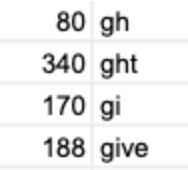
A simple slip to make for someone writing coded letters late at night in low candlelight.
If you want to play along:
Here’s the code/decode spreadsheet.
And here is the transcribed text (underlines for plurals, asterisk for added “e”). I've given the solution under the cut!
I have employed the most unremitting efforts to obtain a prompt and favorable decision relative to the object of my mission_ 381, 304, 543, 437, 366, 377, 276, 75, 75, 226, 269, 385, 426, 377, 17, 465, 197, 481, 428, 593, 381, 355, 153, 278*, 428, 333, 70, 18, 405, 184, 226, 291, 197, 376, 524, 330, 446, 362, 449, 143
The Count de Vergennes communicated to me yesterday his most Christian Majesty's determination to guarantee 381, 59, 594, 18, 9, 205, 330, 497, 254, 401, 376, 503, 306, 503, 467, 428, 226, 236, 330, 278*, 245, 205, 506, 99, 376, 381, 381, 256, 184, 90, 340, 304, 196
...and the value of the military effects which may be furnished from the Royal Arsenal, 418, 330, 497, 428, 197, 380, 377, 196, 376, 45, 278, 245, 205
I shall use my utmost endeavours to procure an immediate 467, 208, 491, 18, 278*, 9, 205, 45, 278, 42, 381, 230, 215, 355, 18, 237, 330, 497*, 215, 167, 290, 377, 376, 341, 278, 182, 302, 75, 376, 59, 594, and shall renew my solicitations for the 357, 34, 197, 18, 203, 291, 491, 481, 484, 34, 325, 89, 113, 392, 197, 269, 336, 458, 278*, 97, 18, 245, 205 may not be 126, 21, 215, 497, 376, 341, 296, 75, 477, 226, 103, 196, 481, 278*, 483, 215, 553, 75*, 18, 238, 377, 59, 374, 478, the providing this article I fear will be attended with great difficulties and delays as all the 476, 490, 481, 36, 228, 351, 392, 226, 197, 18, 237, are remote from the sea, and there are no 441, 420, 50, 563, 503, 197, 18, 377, 59, 278, suitable to our purposes.
The cargo of the Marquis de la Fayette will I hope arrive safe under the convoy of the Alliance_ 481, 341, 78, 465, 75, 426, 408, 596, 115, 76, 376, 174, 196*, 291, 103, 197, 75, 75, 184, 226, 197, 281, 5, 171, 278*, 428, 593, 381, 355, 492, 194, 236, 376, 45, 574, 408, 504, 366, 381, 506, 197, 197, 193, 213, 75, 197, 199, 291, 377, 197
The Marquis de Castries has engaged to make immediate arrangements for the safe transportation of the pecuniary and the other succours destined for the United States_ 481, 350, 215, 167, 450, 196, 376, 34, 381, 75, 473, 376, 76*, 458, 278*, 72, 208, 449, 577, 114, 89, 405, 486, 497, 197, 113, 126, 34, 361, 376, 269, 278*, 277, 291, 104, 381, 113, 278*, 401, 230, 408, 550, 552, 342, 291
Have fun!

I have employed the most unremitting efforts to obtain a prompt and favorable decision relative to the object of my mission_ after many discussions, difficulties and delays with the details of which it is needless to trouble congress.

The Count de Vergennes communicated to me yesterday his most Christian Majesty's determination to guarantee a loan of ten millions to be opened in Holland in addition to the six millions granted as a gracious gift.

...and the value of the military effects which may be furnished from the Royal Arsenal are to be deducted from the six million.

I shall use my utmost endeavours to procure an immediate advance of the ten millions from the treasury of France to be replaced by the proposed loan,
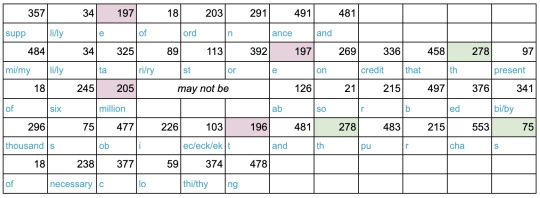
and shall renew my solicitations for the supplies of the ordinance and military stores on credit that the present of six millions may not be absorbed by thousands objects and the purchase of necessary clothing

the providing this article I fear will be attended with great difficulties and delays as all the wool and manufactories of France are remote from the sea, and there are no

public magazines of cloth suitable to our purposes.

The cargo of the Marquis de la Fayette will I hope arrive safe under the convoy of the Alliance_ and by satisfying our immediate necessities prevent the delays above-mentioned from having any disagreeable consequences
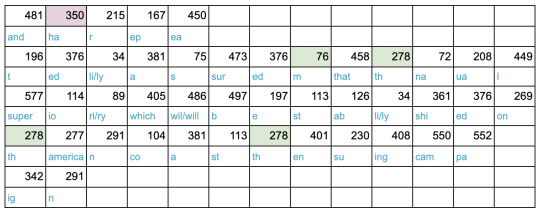
The Marquis de Castries has engaged to make immediate arrangements for the safe transportation of the pecuniary and the other succours destined for the United States_ and has repeatedly assured me that the naval superiority which will be established on the American coast the ensuing campaign
#historical john laurens#john laurens#amrev#18th century history#code breaking#it's my birthday so naturally i must give all my beloved mutuals and followers a lil gift#let me know what results you got!!
78 notes
·
View notes
Text
S-Classes that I raised/My S-Class Hunters information post


내가 키운 S급들 | S-Classes that I raised (“SCTIR”) is an ongoing Korean fantasy webnovel on Munpia, Naver, Ridibooks, and Kakao by 근서 | Geunseo that has been adapted into an ongoing manhwa/webcomic (My S-Class Hunters) (though the manhwa is on hiatus at the moment after the conclusion of season 1). The second cover art is by onlyraii. The novel is published by 제이플미디어 | JAYPLEMEDIA.
Manhwa adaptation summary: "Yoojin is an F-ranker overshadowed by his little brother, an S-ranker. All he does is get in his brother’s way, causing trouble wherever he goes. When a seemingly routine dungeon raid goes wrong and costs Yoojin his brother’s life, Yoojin decides to use the wish granted by clearing the dungeon to reset his timeline. The plan was to lead a quiet life from now on… but now it turns out he can help other people become S-rankers?! Maybe this is Yoojin’s chance at building his own entourage of powerful metahumans… but it may be easier said than done." - Naver Webtoon
SCTIR the webnovel has an 858-episode main story, a 14-episode epilogue, a completed 167-episode Side Story (sequel) and an ongoing 27-episode Afterward/Later Story (sequel). It was first published on June 29th, 2018 (Munpia).

The main story and epilogue were reformatted into 35 ebooks (Naver, Ridibooks, Kakao), which began publication on May 1st, 2020, and the ebooks have interior illustrations from 비완 | Biwan for volumes 1-14 and a few other artists for the other 21 volumes. Here's a post on some of the interior art that JPLE has shared online.
The ebooks also have extra scenes in various places and possible revisions, which differs from what is available in the individual episodes.
A guide for reading SCTIR on Munpia and Naver (this is meant for another fandom, but it's also designed to work for anyone who wants to read any similar works on Munpia and Naver).
This is meant to be a collective post for information on the novel and manhwa, as well as translations, which will update as new information comes up.
Geunseo
Geunseo is the author of the webnovel. Back in mid-2022, Geunseo replied to questions from readers in a very long Q&A, which folks shared on various platforms.
Translations of the webnovel
There is no official English translation of the webnovel, though there are a few fan translators, but most are just people putting the episodes through machine translators ("MTL") and sharing those online, or doing modified/partial MTL, which involves MTL most/all of the episode and doing partial translation/editing on the results. There is also a lot of confusion because people tend to MTL the individual episodes, not the revised ebooks, so folks reading one but not the other one are going to have different understandings of the story.
Side Stories/Sequels
There are two side stories for SCTIR, both of which are sequels to the part that came before. The order is main story (not an official name, it's just the regular story) > Epilogue > Side Story > Afterward/Later Story. Side Story and Afterward/Later Story are only available on Naver for some reason.
SCTIR manhwa, My S-Class Hunters


SCTIR's manhwa adaptation is published on Naver Comics / Naver Series, began publication on November 15th, 2021, and is 153 episodes long. There's a trailer from right before it released on YouTube.
youtube
The manhwa is adapted by 제이플미디어 | JAYPLEMEDIA, with principle art by 비완 | Biwan, and the head of storyboard is seri. Other crew on the team include 징개 JINGGAE | JING_GAE (assistant direction), 김피로(KPR) | tired_kim, and 한흔 | hanheunhan. A lot of the crew share previews and behind the scenes material on their twitters. Although the manhwa is very far behind the novel, the crew are generally novel fans (Biwan did art for the ebooks, after all), and they will also sometimes do fanart for recent episodes of Side Story/Afterward, so be wary if you want to avoid spoilers. The manhwa currently stops in volume 7 of the novel, around episode 168.
The manhwa also differs in many ways from the novel, which is normal for an adaptation. Changes include some chronological reorganization of events, expansion of certain characters and relationships, some modifications to skills, additional scenes, etc.
The original Korean updates weekly on Naver on Tuesdays around 10:30-11:00 AM ET, though it's currently on hiatus after the conclusion of season 1. All translations are currently some ways behind the original Korean, so they have a bit to catch up on during the hiatus if they're ongoing.
The English translation updates weekly at 9 PM ET on Wednesdays on Webtoon, and at 00:00 ET on Wednesdays on Tappytoon. The Webtoon version is free to read, but the last several episodes are paywalled, and these episodes can be accessed by cookies (the currency on Webtoon). Guide for how to read for free on Tappytoon. SCTIR's manhwa is also available online in French (though it seems to be on a hiatus since 2022), German, Japanese (俺が育てたS級たち), Spanish (Los clase S que crié), and Thai.
April Fool's Day Jokes
Both the novel and manhwa teams, like a lot of Webtoon manhwa teams, usually do a joke post for April Fool's Day.
The 2022 joke post for the novel was seemingly a parody of the then-unreleased novel cover by onlyraii. The 2022 joke post for the manhwa was a magical girl Yoohyun parody.

The 2023 joke post for the manhwa was Yoojin, Yerim, Yoohyun, and Peace making heart signs.

The 2024 joke post for the manhwa was to have most of the cast become dinosaurs.

50 notes
·
View notes
Text

History of the Hughes OH-6 Cayuse Helicopter
The Hughes OH-6 Cayuse, also known as the "Loach," is a single-engine light helicopter that was developed by Hughes Helicopters. Here is a summary of its history after production and launch:
- The OH-6 Cayuse was developed to meet the United States Army's Technical Specification 153, which was issued in 1960 to replace its Bell H-13 Sioux fleet.
- Hughes competed against two other finalists, Fairchild-Hiller and Bell, for a production contract. In May 1965, the U.S. Army awarded a production contract to Hughes for the OH-6 Cayuse.
- The initial order was for 714 rotorcraft, but it was subsequently increased to 1,300 with an option for another 114.
- The OH-6 Cayuse entered service with the U.S. Army in 1966.
- The OH-6 Cayuse was used for various missions, including personnel transport, escort and attack operations, and observation.
- The OH-6 Cayuse set 23 world records in the 1960s, including speed, endurance, and time to climb records.
- In 1968, Hughes faced competition from Bell's OH-58 Kiowa, which led to the production of the original OH-6 Cayuse halting in 1970.
- The OH-6 Cayuse's design caught the attention of McDonnell Douglas in the 1980s, leading to further developments and adaptations, such as the MH-6 Little Bird, which showcased versatility with options for different weapons.
- The civilian version of the Cayuse, known as the MD 500, is still produced by MD Helicopters.
- The OH-6 Cayuse continued to serve with the U.S. Army's Special Forces and found popularity with civilian pilots and law enforcement agencies.
- The OH-6 Cayuse's contributions to military reconnaissance and its versatility in combat make it a notable subject for military aviation enthusiasts and model collectors.
44 notes
·
View notes
Note
Can we hear about your milgram oc 🥺🥺
( no pressure ofc )
I have 12 Milgram OCs! But now there are only 8 ( or 9 ? ) people who have stories. I'll introduce them to you!!↓

(I use Translate app and my little abilities, hope you can read and understand it.)
In Samleegram, We have 2 prison guards and 10 prisoners
Prison Guards
[000]
Name : Es (エス)
CV : Sakamoto Maaya (坂本 真綾)
Gender : Unknown
Age : 15
Birthday : Unknown
Height : 153 cm.
Bloodtype : Unknown
Image color : #8EC6BB (Monte Carlo)
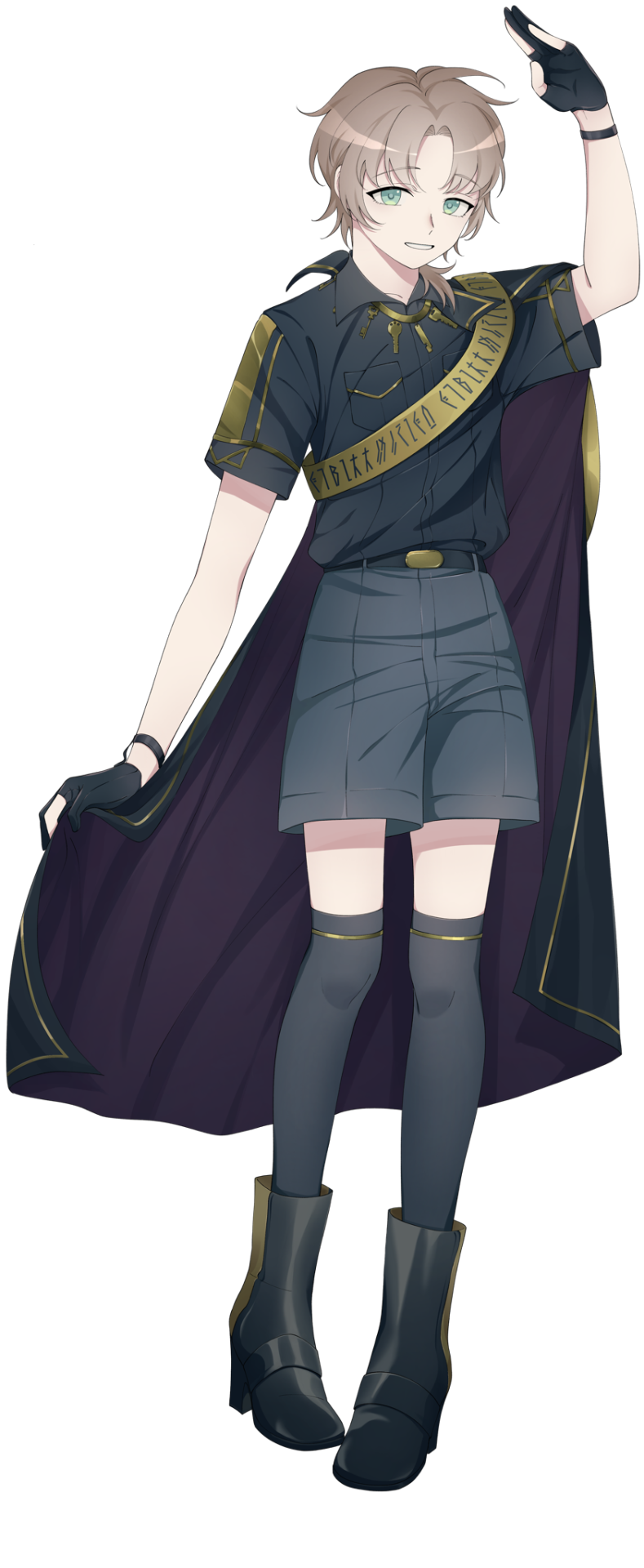
Es bright and cheerful, They is close to almost every prisoner. They always make free time to talk with prisoners. But no one knew that they was secretly recording prisoners' information all the time.
They patrolled at night every day. Many people think it's because they works hard. But actually they was just trying to find a way out of here.
Es often gets teased by Ar for being short. So they asks Jackalope for a new pair of shoes. That makes them 160 cm tall. which is higher than Ar. LOL
((Es rarely wears a hat because it makes seeing difficult.😢 Es always cooks for everyone to eat, sometimes some prisoners come to help them. (but Ar doesn't help.)))
__________
[000]
Name : Ar (アル)
CV : Uchiyama Yumi (内山 夕実)
Gender : Unknown
Age : 15
Birthday : Unknown
Height : 159 cm.
Bloodtype : Unknown
Image color : #8EB8C6 (Polo Blue)

In fact, Ar was the assistant prison guard. Its main duty is to interrogate prisoners. They was verbally violent during the interrogation. In this prison, there was hardly anyone to like them. (← It should be like that)
Ar is very foul-mouthed and has a temper. (💀) Do you see that whistle? They usually blow it when prisoners don't behave as they please. ( Why does it sound cute..? )
((Ar doesn't often wear hats either. But it's because he's just lazy. Sometimes Ar wears Es’s hat because Ar can't find their own.))
__________
Prisoners
[021]
Name : Kinoshita Haru (木下 晴)
CV : Kitamura Eri (喜多村 英梨)
Gender : Female
Age : 22
Birthday : January 6
Height : 173 cm.
Bloodtype : A
Image color : #F59795 (Wewak)
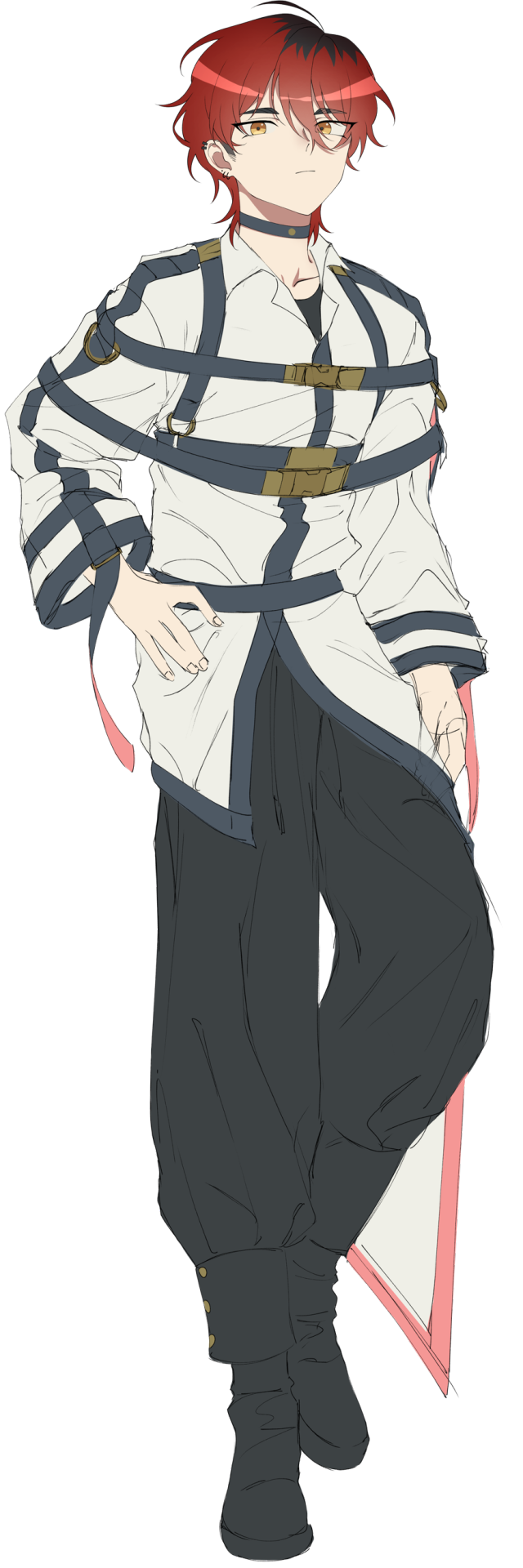
Haru hardly speaks to anyone. She usually communicates by writing on the board. She also isn't good at facial expressions, which makes some people think she's strange.
Haru often smokes with Masato (024) regularly. And She seem to be trying to approach Akihiko (26) for unknown reasons.
She used to like to sing and play music, she used to set up a band with a close friend before. But why did she stop doing it? Hmmm? you'll have to wait until this part of the story is revealed.✌️
((I intend to design Haru to look like a man. Due to her past story But she is a woman. However You can use the anypronoun with her that she/her he/him or they/them. She doesn't seriously about this.))
__________
[022]
Name : Murata Kei (村田 軽 )
CV : Murata Ayumu (村瀬 歩)
Gender : Male
Age : 14
Birthday : August 19
Height : 154 cm.
Bloodtype : AB
Image color : #BCCCD1 (Link Water)

Kei is the youngest prisoner. He has dark circles under his eyes that are clearly visible. It's because he almost didn't sleep. Even though he went to sleep, he had a nightmare anyway, so he thought it was better to take that time to study.
He often said that he was not guilty , Never kill people , Milgram caught him wrong. And he wanted to leave here very much. 'My father will definitely find me.' He always said that.
Kei looks particularly close to Hinata(023), maybe because of his similar age, he often follows her like a chick(?) Everyone in prison always sees them next to each other.
((He used to ask for cosmetics from Es, so Es thought that in fact, he might love beauty?))
__________
[023]
Name : Tsugiyama Hinata (杉山 日向)
CV : Hanazawa Kana (花澤 香菜)
Gender : Female
Age : 15
Birthday : March 23
Height : 148 cm.
Bloodtype : A
Image color : #F4CFC5 (Coral Candy)
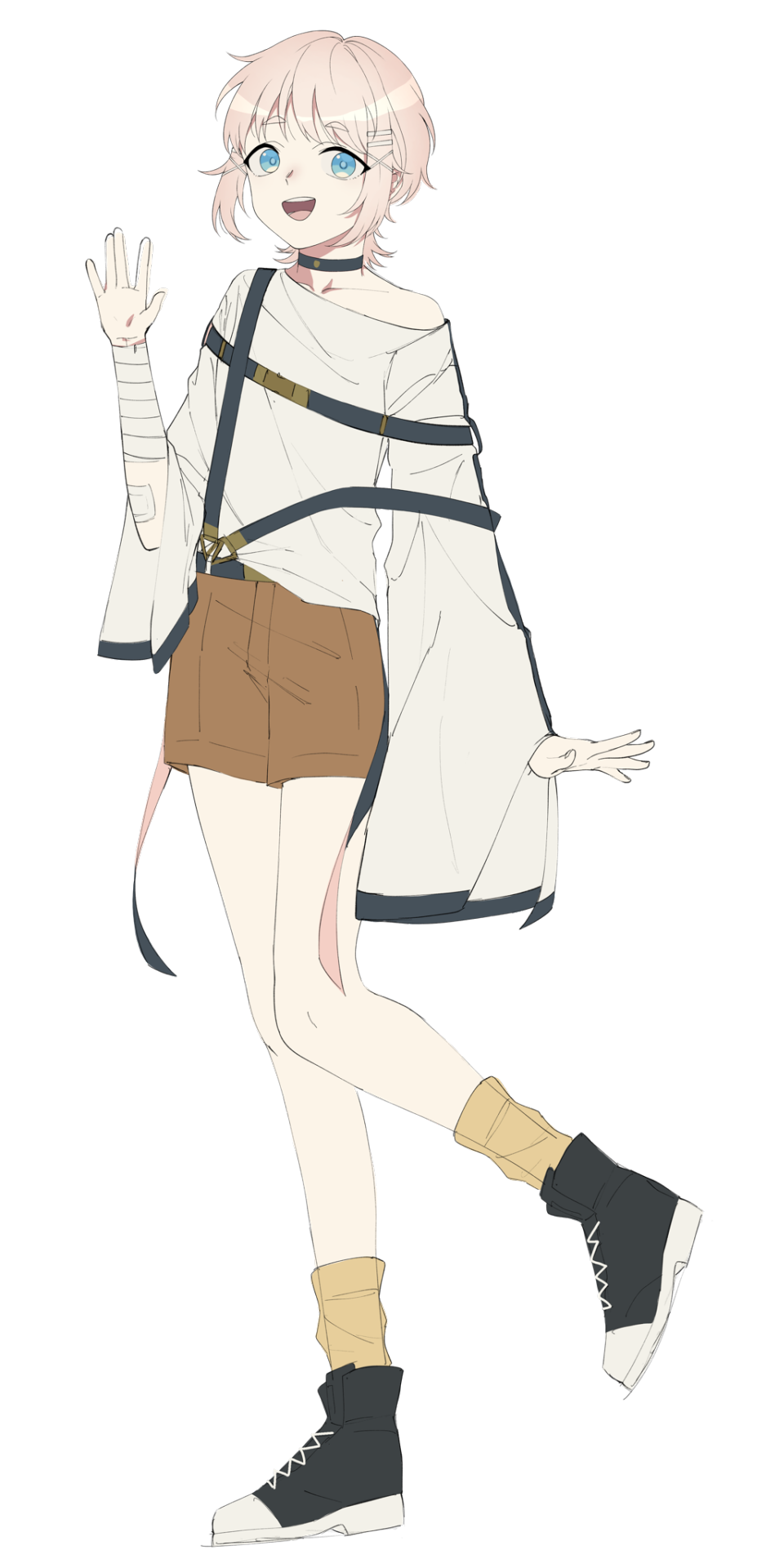
Hinata is a friendly person and always talks to others. Everyone sees her cheerful and looks polite all the time. But once in a while she accidentally slipped out of a rude word. Make everyone shock…
She bandaged her arms all the time. Ritsu (028) volunteered to change the bandage for her often, but she often refused him and did it on her own. She didn't want anyone to see the that wound.
Hinata didn't have the attitude of wanting to leave milgram at all. Hinata thought that this place was much more comfortable than her house. If not sticking to the vote that she didn't like it.
((Hinata doesn't like the uniform that Milgram provides. Because it makes everyone see the bandage clearly.💢))
__________
[024]
Name : Kimura Masato (木村 正人)
CV : Hirata Hiroki (平田 広明)
Gender : Male
Age : 43
Birthday : February 20
Height : 187 cm.
Bloodtype : O
Image color : #78BC8E (Bay Leaf)

He is the oldest person in milgram. He lived a sluggish life as if he had completely lost faith in this world. Sometimes he acted like a father of children in prison.👴
Masato talks to Ritsu(028) most often. discussing life problems, adult edition (sounds depressing). He often smokes with Haru(021) on a regular basis, even if the other party lets him talk to a single swim.
Masato didn't pay much attention to milgram, But if he could choose, he wanted to get out of here, Because he still didn't complete his duty.
((He thinks it's not bad to have free cigarettes.))
__________
[026]
Name : Matsui Akihiko (松井 昭彦)
CV : Taniyama Kishou (谷山 紀章)
Gender : Male
Age : 18
Birthday : April 1
Height : 169 cm.
Bloodtype : A
Image color : #FFBF65 (Rajah)

I haven't made much of his story yet. But as you can see, He's not very friendly.
Akihiko often quarrels with Ar regularly (He actually quarrels with everyone but.. uh… with Ar the most.)
__________
[028]
Name : Itsuki Ritsu (樹 律)
CV : Furukawa Makoto (古川 慎)
Gender : Male
Age : 35
Birthday : June 30
Height : 182 cm.
Bloodtype : B
Image color : #3359BF (Cerulean Blue)

Please marry m- NO, I mean, Ritsu always takes care of others, maybe because he's a doctor, so he's trusted by everyone.
He is very close to Masato(024), probably because Masato is the male of his age closest to himself.
((Look at his smile ^^ 🥺))
__________
[030]
Name : Higuchi Ryota (樋口 僚太)
CV : Uchida Yuma (内田 雄馬)
Gender : Male
Age : 20
Birthday : October 12
Height : 174 cm.
Bloodtype : O
Image color : #C1D48C (Deco)
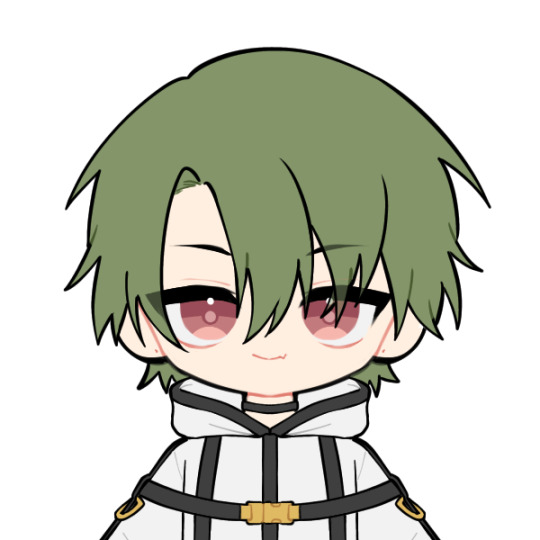
Ryota doesn't have any other information yet, I'll update it later!
__________
Thank you for reading to the end!!
56 notes
·
View notes
Note
hey! I'm currently writing a paper discussing experiences of disabled and neurodivergent students at my uni (spoiler alert: it's not great lmao), and while I have a couple references so far (mostly Lund and Pearlstein) about the larger Disabled Student ExperienceTM I'm struggling to find academic papers talking about this, particularly since my field of study is psychology rather than disability theory/disability justice. are there any texts regarding this that you would reccommend? doing my best to lean on crip theory for this essay and you were the first person i thought of! no worries if you don't have the energy to answer this rn ofc, i hope you're having a good day ✨
omg what a fabulous & vital project! i’d love to hear more about your work both out of interest & to potentially refine my recommendations because this is such a complex, multifaceted area of experience + research + activism — i tried to draw from a variety of perspectives so you can dig deeper into what seems most relevant!
my number one recommendation is the book Academic Ableism by Jay Dolmage, i still need to read most of it rip but it’s absolutely considered foundational in this topic. the rest i’m gonna put under a cut because it got super long lol, i’ll also reblog to my disability sideblog @crippleprophet in case anyone else has suggestions!
best of luck with your work, i hope some of this is helpful! feel free to reach out for more recommendations, input, or encouragement❣️💖
on the built environment – eg, the physical campus & how it impacts students
if you’re in the US, this summary of colleges’ responsibilities under the ADA has been helpful for me (link).
Building Access by Aimi Hamraie
Accessibility for Historic Buildings: A Field Guide, 2nd Edition (link to pdf)
written by David Provost and revised by Joseph Hoefferle, Jr. as part of the University of Vermont Graduate Program in Historic Preservation
back in 2020 i used the first edition of this document in a project arguing my undergraduate university should make its historic buildings more accessible
lays out policies & options in tables with photo examples from their campus
Aimi Hamraie & Kelly Fritsch’s Crip Technoscience Manifesto (2019)
Catalyst: Feminism, Theory, Technoscience, 5(1), pp1-34.
this piece is honestly just incredibly life-giving for me in general so i highly recommend giving it a full read when you have time. specific parts that i thought might resonate with the experiences of students at your uni:
“user-initiated design” (Hendren & Lynch, cited p9)
“access as friction” (p10):
Emerging out of historical fights for disability rights, the terms accessibility and access are usually taken to mean disabled inclusion and assimilation into normative able-bodied relations and built environments. […] However, the etymology of the word access reveals two frictional meanings: access as “an opportunity enabling contact,” as well as “a kind of attack” (2016, p. 23). Taking access as a kind of attack reveals access-making as a site of political friction and contestation. While historically central to the fights for disability access, crip technoscience is nevertheless committed to pushing beyond liberal and assimilation-based approaches to accessibility, which emphasize inclusion in mainstream society, to pursue access as friction, particularly paying attention to access-making as disabled peoples’ acts of non-compliance and protest.
noncompliant users and assistive technology as friction (p11):
Lifchez and Winslow offer the concept of “non-compliant users,” illustrating this with an image of a powerchair user wheeling against traffic on a street without curb cuts (1979, p. 153). This technology-enabled movement against the flow of traffic marks anti-assimilationist crip mobility: not an attempt to integrate (as in the liberal approach to disability rights), but rather to use technology as a friction against an inaccessible environment.
collaborative mapping of (in)accessibility, something i know happens more informally among disabled students on many campuses (p15):
Unlike mainstream disability technoscience “crowdsourcing” projects, which invoke a charity model of disability wherein non-disabled people collect data but do not engage in disability culture or politics, emerging projects such as Mapping Access are making participatory access-making the basis of a kind of technoscientific “access intimacy” (Mingus, 2017) through practices such as “critical crowdsourcing” of accessibility data (Hamraie, 2018). […] Collaborative mapping visualizes the evidence of inaccessibility while creating opportunities for collective response. Crip cartographic technoscience thus enables more critical design, and interrogation of the everyday built environment.
access to education
the United Nations Convention on the Rights of Persons with Disabilities includes the right to inclusive education (Article 24). scholarship in this area is about primary & secondary education, not postsecondary / university education, but a lot of the concepts can be applied
in addition to inclusive education, “universal design for learning” (UDL) might be a helpful keyword but it definitely trends toward the liberal as a whole
“Hidden contradictions and conditionality: conceptualisations of inclusive education in international human rights law” (2013) by Bronagh Byrne (link)
references the importance of identifying barriers as a step in the process of accessible education, which depending on your work may be a nice succinct justification of its necessity (p234):
Inclusion ‘necessitates the removal of the material, ideological, political and economic barriers that legitimate and reproduce in equality and discrimination in the lives of disabled people’ (Barton and Armstrong 2001, 214). According to this view, an identification of barriers within the school’s environment, teaching and learning strategies, and attitudes that prevent the full participation of children with disabilities, will also be required.
argues for a focus on inability of schools to meet students’ needs rather than students’ inability to conform to an ableist environment (for example, p242):
International human rights law has conditionalised the right to inclusive education for children with disabilities by making inclusion contingent upon the extent of individual rather than institutional or structural deficits.
psychological/emotional impact on disabled students
“psycho-emotional disablism” may be a useful search term for you, with the disclaimer that a substantial portion of scholars in feminist disability studies are TERFs / express “gender critical” beliefs / etc. so like i’m listing one paper i came across that looked relevant + two from my grad program’s recommended reading, but i haven’t read these & suggest vetting authors before citing them:
“The psycho-emotionally disabling impact of academic landscapes of exclusion: experiences of a disabled postgraduate in perpetual lockdown” (2023) by Joanne Hunt (link)
Reeve, D (2004). Psycho-emotional dimensions of disability and the social model. In C Barnes & G Mercer (eds), Implementing the social model of disability: theory and research. The Disability Press, Leeds, pp. 83-100. http://donnareeve.co.uk/wp-content/uploads/2014/03/ReeveChapter2004b.pdf
Reeve, D. (2014) 'Psycho-emotional disablism and internalised oppression', in J. Swain, S. French, C. Barnes and C. Thomas (eds) Disabling Barriers - Enabling Environments, 3rd Edition, London: Sage, pp. 92-98. http://donnareeve.co.uk/wp-content/uploads/2014/03/ReeveChapter2014a.pdf
29 notes
·
View notes
Note
Do you have any physical appearance hc for fem Riddle? 👀 Like, hair length, if she would use jewelry and/or heels...
Aaaaaaaa I love fem riddy so much T°T ❤️
I do!!! >w< please enjoy my thoughts and headcanons!
✧ her hair is long, either around armpit length or mid-back. She often puts it up in prim, elegant styles that mirror how her mother styles her hair, or she does something like these styles below which incorporates braids (my favorite is the one with roses):
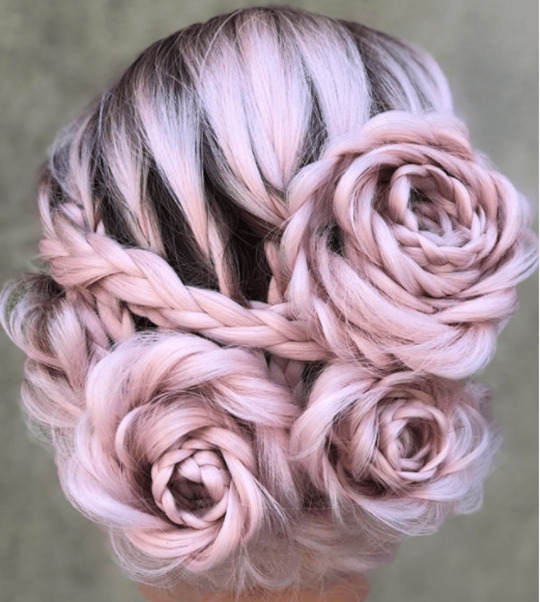


✧ she’s had much the same hairstyle for her whole life. Her mother would be appalled if Riddle expressed interest in cutting her hair anything shorter than shoulder-length.
✧ her mother selected and curated Riddle’s wardrobe, so it isn’t until NRC that she starts to look into other fashion styles. This includes makeup! Her mother probably wanted her to look more natural, so Riddle usually only wore very subtle colors: nudes, soft shades of pink or red, and very light touches of blush. Now she’s free to experiment with all kinds of makeups. She loves red lipstick the most. Additionally, she wears the lolita style. <3
✧ for jewelry, I imagine she wears earrings. Anything with roses or hearts. She likes silver more than gold, but sometimes she’ll match gold with the accents on her dorm uniform (like the crown or on her heels). I feel like she wouldn’t wear a lot of jewelry. She usually just wears earrings, but perhaps she’ll wear a ring or two or a dainty necklace.
✧ as for heels, her mother was immensely strict with heel height. The heels were only allowed to go up to her ankles as well. Nothing more than that (Riddle very happily breaks this rule when she has her dorm uniform heels designed). Modesty is a rule constantly engraved into Riddle, and showing skin is akin to asking for your swift execution in the Rosehearts’s household. Riddle is accustomed to walking in shorter heels, but it’s the taller heels she had to practice more in. She isn’t too fussy about shoes, but she does like heels. There are so many styles and each is more fascinating than the last.
✧ for physical appearance, she’s still petite and short like male Riddle. He’s 160 cm, so I imagine fem Riddle is just a little shorter than that. Something like 153 cm perhaps.
69 notes
·
View notes
Text
#FashionFriday for #DragonflyWeek :


1. Unlined Summer Kimono (Hito-e) with Dragonflies and Stream
Japan, Shōwa, c.1920–30s
Printed silk, 60 1/4 × 51 in. (153 × 129.5 cm)
2. Meisen Summer Kimono with Dragonflies
Japan, Shōwa, c.1940–45
Plain-weave silk warps with twisted dupioni silk wefts in unraveled ikat (hogushi-gasuri), 62 3/4 × 47 3/4 in. (159.4 × 121.3 cm)
The Metropolitan Museum of Art, New York
"The dragonfly (tonbo)...is one of the oldest motifs in Japan, symbolic of patriotism, courage, and good fortune. Samurai warriors considered the dragonfly the victory insect because of its agility and perceived fearlessness. Thriving in watery rice fields, it was also believed to be a sign of a good harvest. Dragonflies appear in various art forms in Japan but became particularly prominent in the bold designs of early twentieth-century kimonos, reflecting the influence of the Western Art Nouveau movement. Their seasonal association made dragonflies appropriate for summer kimonos."
#animals in art#animal holiday#20th century art#1920s#1930s#1940s#kimono#Japanese art#East Asian art#Asian art#dragonfly#dragonflies#animal emblems#animal iconography#Fashion Friday#textiles#fabric#historical costume#fashion#Metropolitan Museum of Art New York
24 notes
·
View notes
Photo

Carina Nebula North : The Great Carina Nebula is home to strange stars and iconic nebulas. Named for its home constellation, the huge star-forming region is larger and brighter than the Great Orion Nebula but less well known because it is so far south -- and because so much of humanity lives so far north. The featured image shows in great detail the northern-most part of the Carina Nebula. Visible nebulas include the semi-circular filaments surrounding the active star Wolf-Rayet 23 (WR23) on the far left. Just left of center is the Gabriela Mistral Nebula consisting of an emission nebula of glowing gas (IC 2599) surrounding the small open cluster of stars (NGC 3324). Above the image center is the larger star cluster NGC 3293, while to its right is the relatively faint emission nebula designated Loden 153. The most famous occupant of the Carina Nebula, however, is not shown. Off the image to the lower right is the bright, erratic, and doomed star star known as Eta Carinae -- a star once one of the brightest stars in the sky and now predicted to explode in a supernova sometime in the next few million years. via NASA
646 notes
·
View notes
Text

Morning
Oh Miss Mo(u)rning, I had a lot of time to think about this pastel goth while working on her.
The frustrating thing about Morning is she's a bit of a timeline mystery. We know she hatched in late 129AC/early 130AC. We are not given a date for her death or an explanation to what could have possibly happened. All we are told is that the last dragon died in 153AC and the last recorded mention of Morning was in 136AC. So there is a 17 year window and a whole lot of speculation.
After the storming of the Dragonpit in 130AC, there were four dragons left alive. Cannibal had disappeared, Sheepstealer and Nettles had flown off and were last sighted in the Vale, and Silverwing had been left feral in the Reach. If we rely on the word of F&B, we can assume that Silverwing died before 153. Morning was the last healthy dragon to hatch, as there are recordings of several more hatched dragons but all were malformed and small. So bear with me as I jump into personal theories and speculation:
I think Morning was born just before the Dragonpit's destruction. There are plenty of meta theories and in book postulations about dragons and their connection to summer and how when the dragons died, summers became shorter and winters harsher. I think that dragons helped maintain some magical ecosystem and their life cycle relied heavily on the latent magic of the world. Morning was lucky enough to have been born right before the death of the remaining Targaryen controlled dragons and I think she managed to grow and thrive off of whatever magical energy inertia was left from their presence. But, I think in the year of her rider Rhaena's husband's death, Morning's rider's grief- due to the bond of a rider and dragon- kickstarted Morning's decline. She stopped growing, her flames grew weaker, and one day Rhaena discovered Morning dead. I think Morning's death also coincides with reports of Silverwing being found dead in her lair. The last healthy dragons of the world did not go out with a bang but faded like dying embers. Magic began to weaken and the world took a turn for the dormant mundane.
Cruelest application of homophones in all of literary history award goes to GRRM for having Rhaena name her hatchling Morning. Rhaena reflected all her hopes and dreams for a post war future into this hatchling, but the damage had been done and the hope of the coming morning turned into the mourning of a family legacy thrown to the pyre. :)
I wasn't entirely sure where I wanted to go with this design until I found the tidbit that Morning was from the latch clutch of eggs laid by Syrax. So I took some design notes from my Syrax piece, using the basic design of her circlet. Morning has none of the hanging coins that many of the other dragons I've drawn have had to show she never saw violence or combat. She looks wan and a bit gaunt as she's in the last stage of her short life. Her billowing loose fit clothing hides her wasting away. The crescent on her circlet and the blue gems are a nod to her being born in the Eyrie while Rhaena was a ward of Jeyne Arryn.
78 notes
·
View notes
Text
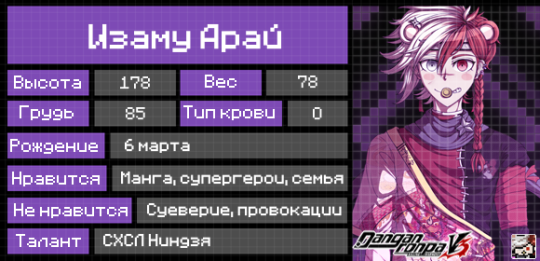
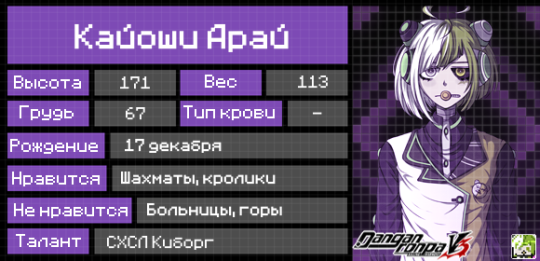
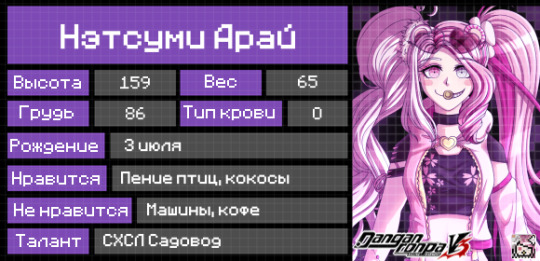
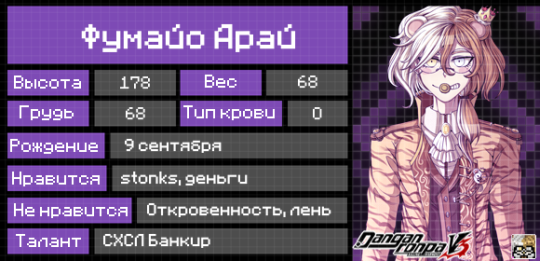
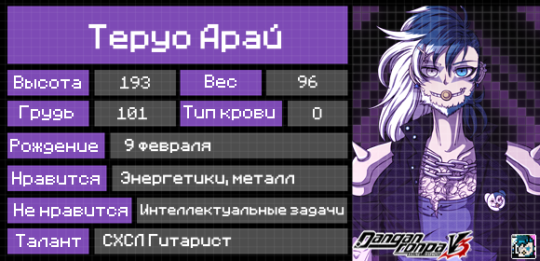

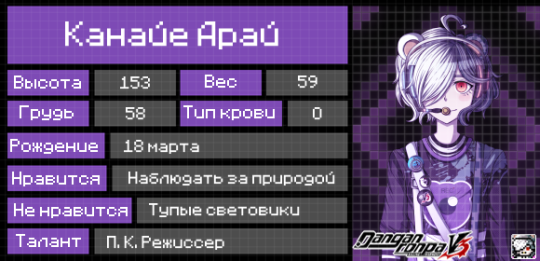
IZAMU ARAI
Height: 178 cm
Weight: 70 kg
Chest: 85 cm
Birthday: March 6th
Blood Type: 0
Likes: Manga, Superheroes, family
Do Not Likes: Superstition, Provocations
Talent: Ninja
KAYOSHI ARAI
Height: 171 cm
Weight: 113 kg (metal parts after all)
Chest: 67 cm
Birthday: December 17th
Blood Type: -
Likes: Chess, Rabbits
Do Not Likes: Hospitals, Mountains
Talent: Cyborg
NETSUMI ARAI
Height: 159 cm
Weight: 65 kg
Chest: 86 cm
Birthday: Jule 3rd
Blood Type: 0
Likes: Birds singing, Coconuts
Do Not Likes: Cars, coffee
Talent: Gardener
FUMAYO ARAI
Height: 178 cm
Weight: 68 kg
Chest: 68 cm
Birthday: September 9th
Blood Type: 0
Likes: Money
Do Not Likes: Frankness, Laziness
Talent: Banker
TERUO ARAI
Height: 193 cm
Weight: 96 kg
Chest: 101 cm
Birthday: February 9th
Blood Type: 0
Likes: Energy, Metal (music)
Do Not Likes: Intellectual tasks
Talent: Guitarist
FUMIKO ARAI
Height: 163 cm
Weight: 68 kg
Chest: 90 cm
Birthday: January 12th
Blood Type: 0
Likes: Holographic fabric
Do Not Likes: Kimchi
Talent: Designer
KANAYE ARAI
Height: 153 cm
Weight: 59 kg
Chest: 58 cm
Birthday: March 18th
Blood Type: 0
Likes: Observe nature
Do Not Likes: Dumb light workers
Talent: Li'l Ultimate Director
16 notes
·
View notes